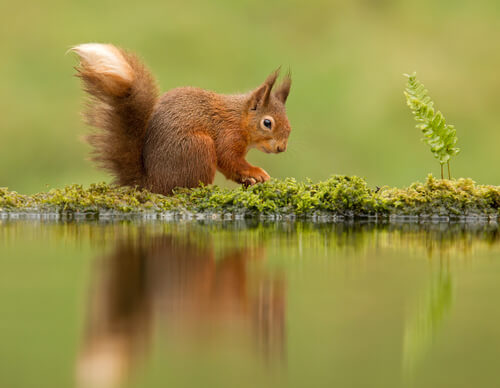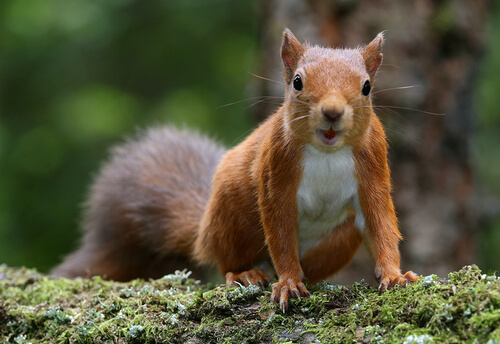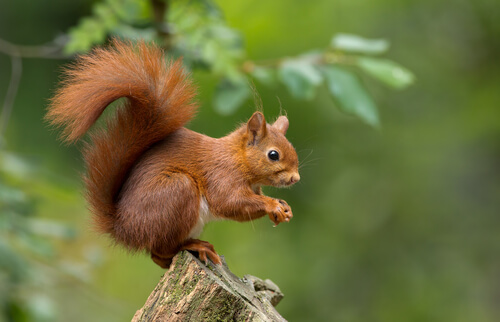
| Kingdom | Animalia |
| Phylum | Chordata |
| Class | Mammalia |
| Order | Rodentia |
| Family | Sciuridae |
| Genus | Sciurus |
| Species | S. vulgaris |
| Niche | Seed dispersing rodent |
| Length | 8 in (21 cm) |
| Weight | 12 oz (330 g) |
| Lifespan | 5-10 years |
| Social Structure | Solitary outside of breeding season |
| Conservation Status | Least Concern |
| Preferred Habitat | Boreal forests |
| Average Litter Size | 3-6 |
| Main Food Items | Seeds, nuts, fruits, insects |
| Predators | Bird of prey, foxes, wolves, cats |
The Basics
The red squirrel (Sciurus vulgaris) is a species of tree squirrel that is commonly found throughout Europe. To distinguish it from the American red squirrel (Tamiasciurus spp.), it is often referred to as the Eurasian red squirrel. S. vulgaris occupies boreal and coniferous forests throughout Europe and Siberia and has a particular preference for certain trees such as Scots pine, Norway spruce, and Siberian pine.
The red squirrel is a small rodent with a bushy tail. It is typically a rust-red color with a white or cream-colored underside and some white coloration near the end of its tail as well. However, various color morphs exist, ranging from black to red. Red squirrels shed their coat twice per year, so coat color varies between seasons as well as between regions.

Eurasian red squirrels weigh 12 ounces (330 g) and grow to about 8 inches (21 cm) long. It is similar in appearance to the American red squirrel, but the Eurasian red squirrel has distinctive horn-like tufts of fur behind its ears. These grow longer with its winter coat and are lacking altogether in the American red squirrel.

Like many animals that live in trees, red squirrels have sharp, curved claws that they use to climb and grip the trees. Here they forage for seeds such as those of pine cones. They also eat various fungi species as well as nuts, berries, and the shoots of young plants. Occasionally they will also eat the eggs or nestlings of birds. Like many squirrels, excess food is cached in various holes in trees or buried for consumption at a later date.
Breeding and Reproduction
Outside of the breeding season, they are generally solitary animals. However, sometimes in winter, several red squirrels will share a drey (nest) to stay warm. What social structure does exist is largely based on age and size, with the dominant animals tending to be older and larger. These larger individuals also tend to have larger home ranges.

Squirrels will build a domed drey out of twigs, moss and, tree bark in natural tree hollows or abandoned woodpecker nests. During the mating season, males will detect females by a smell that they produce and chase her. Sometimes multiple males will chase the female with the dominant male – typically the largest and thus fastest of the suitors – earning the right to mate with the female.
Females typically produce their first litter in their second year, giving birth to about 3-6 hairless young following a 35-day gestation period. Another 4-5 weeks later and the young will leave the nest, although they will continue to be fed by the adult squirrels. By about day 45 they are able to find food for themselves and are no longer dependent on their parents. However, they may remain with the adult female throughout their first summer.
Although populations are decreasing in some areas, red squirrels are still quite common and are listed as “Least Concern” by the IUCN.
Fun Facts about Red Squirrel!
The distinctive ear tufts of the Eurasian red squirrel make it a memorable member of the squirrel family.
Propellor Tails
Their long tail bushy tail is actually a very useful item to squirrels. It helps them to balance when leaping through the treetops and to steer them while airborne. In addition, it can even double as a blanket, keeping squirrels warm and dry in their drey during the winter months.

Two’s a Crowd
In its native habitats such as Great Britain and Ireland, the red squirrel’s numbers have been decreasing in recent years due largely to the introduction of the eastern grey squirrel (S. carolinensis). The eastern grey squirrel is larger than the red squirrel and has been shown to out-compete the red squirrel for food. It also carries a disease known as the squirrel parapoxvirus that apparently doesn’t affect them greatly but is lethal to red squirrels. In some places, this disease has decimated native red squirrel populations by up to 80 percent.
A Natural Fix
The pine marten is a predator that preys on small rodents such as squirrel. Since the introduction of the grey squirrel by humans to Great Britain and Ireland, populations of pine marten in these areas have been increasing as well. These carnivores selectively prey on grey squirrels over red squirrels, potentially helping to control the spread of the invasive species at least somewhat.
This, combined with conservation efforts and awareness is aiding in the recovery of the red squirrel, whose populations are now stabilizing in some areas such as Scotland.
